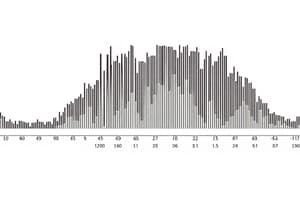Podcast
Questions and Answers
What method allows for straightforward comparisons between groups by analyzing the proportion of subjects exhibiting a certain characteristic?
What method allows for straightforward comparisons between groups by analyzing the proportion of subjects exhibiting a certain characteristic?
- Calculating averages
- Comparing group percentages (correct)
- Correlating scores
- Comparing group means
Which of the following methods is used to determine the relationship between two variables?
Which of the following methods is used to determine the relationship between two variables?
- Calculating frequency distributions
- Comparing group means
- Comparing group percentages
- Correlating scores (correct)
What statistical test is typically used when comparing group means to identify significant differences?
What statistical test is typically used when comparing group means to identify significant differences?
- Regression analysis
- Chi-square tests
- ANOVA or t-tests (correct)
- Correlation coefficients
Which graphical representation of a frequency distribution is specifically used for continuous data?
Which graphical representation of a frequency distribution is specifically used for continuous data?
How is the mean calculated in measures of central tendency?
How is the mean calculated in measures of central tendency?
What is the mode in terms of central tendency?
What is the mode in terms of central tendency?
Which of the following options correctly describes a frequency polygon?
Which of the following options correctly describes a frequency polygon?
Which measure of central tendency is particularly useful for ordinal data?
Which measure of central tendency is particularly useful for ordinal data?
What does a correlation coefficient indicate?
What does a correlation coefficient indicate?
What is the purpose of effect size in research?
What is the purpose of effect size in research?
How is the regression equation represented?
How is the regression equation represented?
What does a standard deviation represent in a dataset?
What does a standard deviation represent in a dataset?
What does partial correlation address in research?
What does partial correlation address in research?
What does variance represent in a dataset?
What does variance represent in a dataset?
What is a multiple correlation used for?
What is a multiple correlation used for?
What is the significance of path diagrams in structural equation models?
What is the significance of path diagrams in structural equation models?
What does a 95% confidence interval imply about repeated studies?
What does a 95% confidence interval imply about repeated studies?
Which scenario represents a Type II error?
Which scenario represents a Type II error?
What is NOT a factor that influences the probability of a Type II error?
What is NOT a factor that influences the probability of a Type II error?
What is the definition of power in a statistical test?
What is the definition of power in a statistical test?
Which statistical test should be selected for comparing three groups with interval/ratio data?
Which statistical test should be selected for comparing three groups with interval/ratio data?
How is Cohen's d calculated?
How is Cohen's d calculated?
Which of the following is true regarding the power of a statistical test?
Which of the following is true regarding the power of a statistical test?
What does Pearson r indicate in correlation studies?
What does Pearson r indicate in correlation studies?
What is the purpose of inferential statistics in research?
What is the purpose of inferential statistics in research?
What does the null hypothesis (H0) state?
What does the null hypothesis (H0) state?
What does a statistical significance level of 0.05 imply?
What does a statistical significance level of 0.05 imply?
How does a one-tailed test differ from a two-tailed test in hypothesis testing?
How does a one-tailed test differ from a two-tailed test in hypothesis testing?
What does the F test evaluate when comparing groups?
What does the F test evaluate when comparing groups?
What is indicated by a large F ratio in an F test?
What is indicated by a large F ratio in an F test?
What does a confidence interval provide regarding a population parameter?
What does a confidence interval provide regarding a population parameter?
Which is not a characteristic of systematic variance in the context of an F test?
Which is not a characteristic of systematic variance in the context of an F test?
Flashcards
Comparing group percentages
Comparing group percentages
Analyzing the proportion of subjects in different groups with a specific characteristic.
Correlating scores
Correlating scores
Assessing the relationship between two variables to see how one predicts the other.
Comparing group means
Comparing group means
Calculating average scores for different groups to find significant differences.
Frequency distribution
Frequency distribution
Signup and view all the flashcards
Mean (M)
Mean (M)
Signup and view all the flashcards
Median (Mdn)
Median (Mdn)
Signup and view all the flashcards
Mode
Mode
Signup and view all the flashcards
Frequency Polygon
Frequency Polygon
Signup and view all the flashcards
Correlation Coefficient
Correlation Coefficient
Signup and view all the flashcards
Effect Size
Effect Size
Signup and view all the flashcards
Regression Equation
Regression Equation
Signup and view all the flashcards
Multiple Correlation
Multiple Correlation
Signup and view all the flashcards
Partial Correlation
Partial Correlation
Signup and view all the flashcards
Third-variable Problem
Third-variable Problem
Signup and view all the flashcards
Structural Equation Models
Structural Equation Models
Signup and view all the flashcards
Path Diagrams
Path Diagrams
Signup and view all the flashcards
Inferential Statistics
Inferential Statistics
Signup and view all the flashcards
Null Hypothesis (H0)
Null Hypothesis (H0)
Signup and view all the flashcards
Research Hypothesis (H1)
Research Hypothesis (H1)
Signup and view all the flashcards
Statistical Significance
Statistical Significance
Signup and view all the flashcards
T-test
T-test
Signup and view all the flashcards
One-tailed T-test
One-tailed T-test
Signup and view all the flashcards
F-test
F-test
Signup and view all the flashcards
Confidence Interval (CI)
Confidence Interval (CI)
Signup and view all the flashcards
Type I Error
Type I Error
Signup and view all the flashcards
Type II Error
Type II Error
Signup and view all the flashcards
Power of a Test
Power of a Test
Signup and view all the flashcards
Factors Influencing Power
Factors Influencing Power
Signup and view all the flashcards
Nonsignificant Results
Nonsignificant Results
Signup and view all the flashcards
Cohen's d
Cohen's d
Signup and view all the flashcards
Pearson r
Pearson r
Signup and view all the flashcards
Choosing a Statistical Test
Choosing a Statistical Test
Signup and view all the flashcards
Study Notes
Describing Results
- Comparing group percentages: Analyzing the proportion of subjects in different groups exhibiting a characteristic. This allows easy comparisons.
- Correlating scores: Assesses the relationship between two variables, quantifying how one predicts the other. This is often done using correlation coefficients.
- Comparing group means: Calculates average scores of different groups to identify significant differences. This typically uses t-tests or ANOVA.
Frequency Distributions
- A frequency distribution summarizes the occurrences of each score in a dataset. This reveals data shape and spread.
- Graphical representations, like pie charts, bar graphs, frequency polygons, and histograms, display frequency distributions.
- Pie charts show proportions in categories.
- Bar graphs use rectangular bars to represent categorical data.
- Frequency polygons connect points representing frequency of each score.
- Histograms show score frequencies within specified ranges (like bar graphs but for continuous data).
Measures of Central Tendency and Variability
- Central tendency: Summarizes a dataset using a single value representing the data's center.
- Mean (M): Average score, calculated by summing all scores and dividing by the total count.
- Median (Mdn): Middle score, dividing the dataset into two equal halves. Useful for ordinal data.
- Mode: Most frequently occurring score, applicable for nominal data.
- Variability: Describes the spread of scores in a dataset.
- Standard Deviation (SD): Average distance of scores from the mean, indicating data spread.
- Variance (s²): Square of the standard deviation, representing the degree of spread.
Correlation Coefficient
- Quantifies the strength and direction of a relationship between two variables.
- Ranges from -1.0 (perfect negative correlation) to +1.0 (perfect positive correlation).
- Values close to 0 indicate weak relationships.
Effect Size
- Quantifies the strength of a relationship between variables beyond statistical significance.
- Helps assess the practical significance of findings.
Regression Equations and Multiple Correlation
- Used to predict one variable based on another (or others).
- Y represents the variable you want to predict, while X represents independent variables.
Partial Correlation
- Addresses the third-variable problem by holding a third variable constant to determine the relationship between two key variables.
Structural Equation Models
- Describes the expected relationships among quantitative non-experimental variables.
- Uses path diagrams (visual representations) to represent causal relationships.
Inferential Statistics
- Used to make conclusions about a population based on sample data.
- Helps evaluate hypotheses.
Null and Research Hypotheses
- Null hypothesis (H₀): Posits no effect or difference in the population.
- Research hypothesis (H₁): Suggests a significant effect or difference.
t-test
- Determines if there's a significant difference between the means of two groups.
- One-tailed test: When the research hypothesis specifies a direction of difference.
- Two-tailed test: When no direction of difference is specified.
F-test
- Compares systematic variance (between-group differences) against error variance (within-group differences), in samples with more than two groups.
- A large F-ratio indicates a higher likelihood of significant results.
Confidence Intervals (CI)
- Provides a range of values where the true population parameter is likely to fall.
- Common level is 95%.
Type I and II Errors
- Type I error: Rejecting a true null hypothesis (false positive).
- Type II error: Failing to reject a false null hypothesis (missed opportunity).
Power of a Statistical Test
- Probability of correctly rejecting the null hypothesis when it's false.
- Influenced by sample size, effect size, and significance level.
Selecting an Appropriate Statistical Test
- Criteria depend on the variables (e.g., groups, types), such as t-tests for 2 groups with interval/ratio data, ANOVA for 3 or more groups, and correlations or regression for relationships between multiple interval/ratio variables.
Effect Size Measures (Cohen's d, Pearson r)
- Cohen's d: Effect size for comparing two means.
- Pearson r: Effect size for correlation. r² represents shared variance.
Studying That Suits You
Use AI to generate personalized quizzes and flashcards to suit your learning preferences.




